Photographs: Reuters Kishore Singh in New Delhi
In the end, he died in exile, which is the pity, because if there is anything Maqbool Fida Husain really wanted, it was to come back home to India.
London, where he succumbed to a coronary attack, aged 96, was like a second home to him -- certainly, he had enough buyers of his work there, but it didn't have the dhabas with the bun-maskas he liked with his tea, or the Jehangir Art Gallery which he treated proprietorially, or the legions of fans who claimed him as their hero.
Hugely talented, extremely competitive, touchingly emotional, Husain was the quintessential Peter Pan of Indian art, its face, and a market leader for six decades -- a superstar who rose from the pavements of Mumbai to create more wealth than he or any other artist at that time would have imagined possible.
. . .
Brand Husain creates legacy value
Image: M F Husain.How much was he worth at the time of his death?
Though art-lovers might be upset at any callous calculation of his wealth, Husain himself would have revelled in it.
Always ahead of the market curve, often on account of a sleight of hand, Husain ensured, till his self-exile from India, that no one approached his prices.
Even in the 50s and 60s, considered his peak painting years, his paintings sold for what were probably the highest prices among his peers of the Progressive Artists' Group (at Rs 400 and more, when others would probably have sold for Rs 150-200).
Towards the end of his life, that premium might have eroded, with everyone from
S H Raza to Tyeb Mehta to F N Souza besting him in the top stakes, but he went out with a fight, claiming the Rs 100-crore (Rs 100-billion) deal he did in 2004 with Guru Swarup Srivastava of the Swarup Group of Industries -- a non-art-lover if ever there was one -- was the biggest-ever money-spinner of Indian art.
. . .
Brand Husain creates legacy value
Image: M F Husain.Photographs: Jay Mandal/On Assignment
Eventually, that commission was never fully realised.
A rough and ready back-of-the-envelope calculation would indicate that in his lifetime Husain probably painted 20,000-odd works (a number, he boasted recently, that probably bested Pablo Picasso's record), and with his drawings and paintings selling for anywhere between Rs 300,000 and Rs 5 crore (Rs 50 million), the market worth of his works at a current average of Rs 20 lakh (Rs 2 million) would be a humungous Rs 4,000 crore (Rs 40 billion).
No wonder Husain lived life giant-sized, indulging himself most recently, in Dubai, with a garage that consisted of a handful of luxury cars including a Bentley, two Jaguars, a Mercedes sports coupe, a Ferrari, a Rolls-Royce, and most recently, a Bugatti.
. . .
Brand Husain creates legacy value
Image: M F Husain.Photographs: Jay Mandal/On Assignment
He had homes in Dubai and London, besides properties in India, a Qatari citizenship which he accepted out of pique, and a brand which will survive well in the history of 20th century Indian modern art.
To start at the beginning, Husain chose 17 September 1915 as his date of birth in the absence of any record in Pandharpur, Maharashtra, where he was born.
His mother died soon after, and he was brought up by his father and grandfather, living in Indore and Baroda, before coming to Bombay determined to become an artist.
Self-taught through painting cinema hoardings, he worked thereafter at a factory where he designed furniture for children's nurseries.
. . .
Brand Husain creates legacy value
Image: Courtesy, Gautam Rajadhyaksha for rediffSouza was quick to spot his talent and inducted him into the Progressive Artists' Group in 1947.
From then on, there was no looking back with Walter Langhammer, Rudy von Leyden and Emmanuel Schlesinger among his mentors and collectors.
Later, no collection of Indian art would be complete without his works, whether Jehangir Nicholson, the Bennett Coleman group, Chester and Davida Herwitz, or museums in India and outside.
Works such as Man and Zameen brought him to the notice of both scholars and the chatterati.
He visited China and was inspired by the artist Chi Pei Shei to paint his iconic horses, was represented at the Venice Biennale, travelled to Czechoslovakia where he fell in love with Maria Jaroslav Zurkova (to whom he gifted 34 paintings, which she later returned), went on to paint his seminal Between the Spider and the Lamp after a visit to Egypt, and made his first documentary film (Through the Eyes of a Painter) which won the Golden Bear at the International Berlin Festival in 1968.
. . .
Brand Husain creates legacy value
Image: MF Husain.Husain's paintings have dealt mostly with Indian mythology.
He has been inspired by both the Ramayana and the Mahabharata (both of which he painted as a series).
His subjects were often village people, musicians and dancers, though he courted controversy when, during the Emergency, he painted Prime Minister Indira Gandhi as Durga riding a tiger.
He satirised the Raj and the princes, became obsessed with Mother Teresa (whom he painted without a face, as an evocation to the anonymity of motherhood), and once painted a set of canvases on stage before a live audience and then obliterated them with white paint.
. . .
Brand Husain creates legacy value
Image: M F Husain.At times he turned gimmicky, strewing newspapers, or spreading white cloth sheets as installations, perplexing critics who could not understand whether this was art or whether Husain was mocking them.
At the same time, he offered salve by way of Theorama, a 120-ft-long canvas consisting of nine 7 ft x 15 ft panels representing the major religions of the world. Among auctions, the highest price accorded to him was for Battle of Ganga and Jamuna: Mahabharat 12, which tipped the gavel at Rs 6.5 crore or Rs 65 million (Christie's New York, 2008), followed by an Untitled oil from 1955 that fetched Rs 4.8 crore or Rs 48 million (Sotheby's New York, 2010), Ritual, Rs 4.2 crore or Rs 42 million (Christie's New York, 2008), Untitled (Arjuna and Krishna), Rs 3.9 crore or Rs 39 million (Christie's London, 2010), and Sita-Hanuman, Rs 3.8 crore or Rs 38 million (Christie's New York, 2008).
Nor was Husain's career limited to just painting.
. . .
Brand Husain creates legacy value
Image: MF Husain paintings.He created three museums of his art in Bengaluru, Ahmedabad and Faridabad, and went on to make feature films starring the actresses Madhuri Dixit and, later, Tabu.
More recently, he was in the news for wanting to make a film with the actress Amrita Rao.
His son, Owais, with whom he lived in London and Dubai, was meanwhile reportedly making a film on his famous father.
His exile, in 2006, followed protests by the right wing, charging him with painting Indian goddesses in the nude -- among them a Saraswati that he had painted in 1975 and Sita being ferried by Hanuman in 1998 -- began with his Mumbai house being vandalised, though the Delhi high court, in 2004, quashed eight criminal cases filed against him.
. . .
Brand Husain creates legacy value
Image: (Bottom) Painter Kekoo Gandhy (top). The family portrait by MF Husain.Photographs: Hitesh Harisinghani/Rediff.com
The sporadic protests picked up pace when an untitled work was renamed Bharat Mata by a gallery owner.
This time Husain was forced to flee to Dubai.
He hoped to return, but the royal family of Qatar, planning a museum on the Islamic civilisation, accorded him an apparently lucrative commission that kept him busy, though visitors that he received from India said he remained broken-hearted and wished to return, but did not want to risk imprisonment or, indeed, harassment at this stage of his life.
Protests about his works at the India Art Summit earlier this year resulted in an unseemly controversy but no damage, indicating that perhaps the artist might be able to stage a comeback.
Husain's legacy is as rich and varied as his life was.
But the moot question is what will happen to his prices following his death.
. . .
Brand Husain creates legacy value
Image: M F Husain at work.Early indications are that prices could nudge up 15 per cent, but with iconic works rare in the open marketplace, they could actually harden by 30 per cent and more for paintings considered important.
The artist who chose to remain barefoot because he said his mother did not live long enough to see him step into his father's shoes will probably have the last laugh as his prices trample over those of others and turn his prodigious output into a mint for his collectors, galleries which have hoarded his works over the last few years, and extended members of his family.
Who among them will execute his estate remains the question that the next days will tellingly unravel.
Meanwhile, to quote Husain (writing to his beloved Maria), "Hold the sky in your hands as the stretch of my canvas is unknown to me."
It truly is.

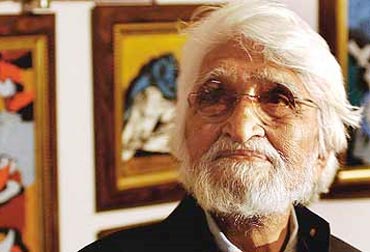
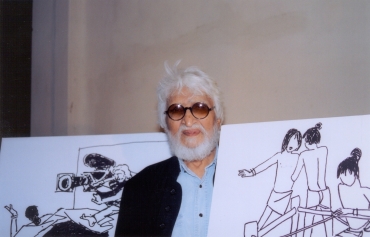
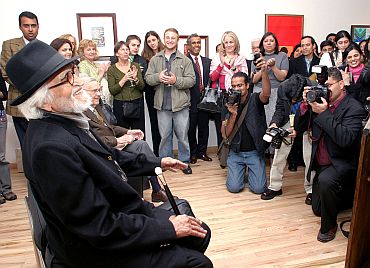
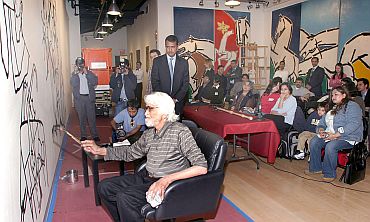
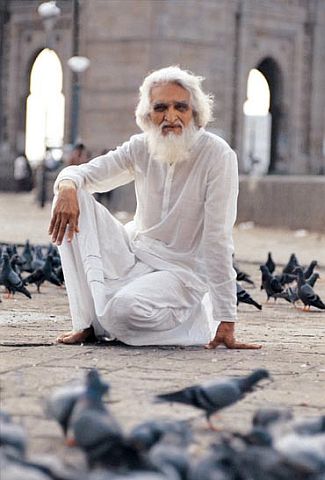
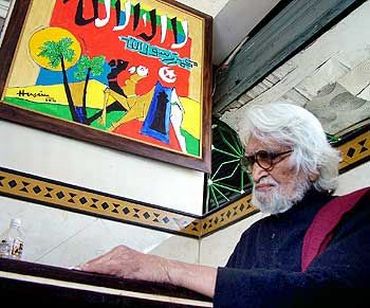
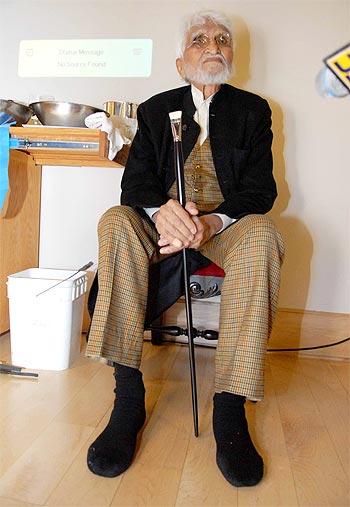
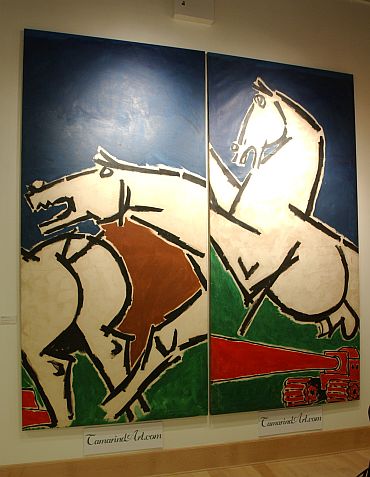
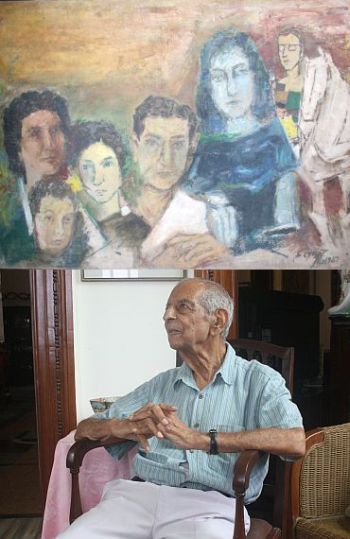
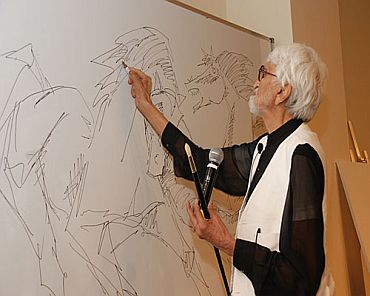

article